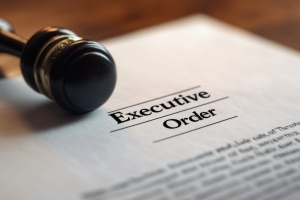What are executive orders and why do they matter?

The executive branch of government is charged with implementing and enforcing the laws passed by the legislative branch. That means the executive branch cannot choose to invent new laws or violate existing laws. However, the chief executive, such as a state governor or the U.S. president, can issue an “executive order” that directs their departments to implement a law a certain way.
Many times, these executive orders are small, such as establishing a commission to coordinate work on one issue. However, executive orders can have sweeping implications – and sometimes cross the line of what is legal. In those cases, the judicial branch can overturn an executive order in the courts.
History of executive orders
Every U.S. president except William Henry Harrison has issued executive orders.
Perhaps most famously, President Abraham Lincoln’s Emancipation Proclamation was an executive order that declared every slave in rebelling states to be free. Lincoln issued more executive orders than any of his predecessors: 48 orders over four years in office.
Executive orders spiked again under President Ulysses S. Grant, who was tasked with reconstruction after the Civil War. He issued 217 executive orders over eight years in office.
The next spike in executive orders came under President Theodore “Teddy” Roosevelt, who issued 1,081 executive orders over his two terms.
President Franklin Delano Roosevelt (FDR) holds the record for the most executive orders: 3,725 over three terms. Many of his orders set up economic interventions in response to the Great Depression. He also used an executive order to force Japanese Americans into internment camps during World War II. Some of his orders were overturned by the U.S. Supreme Court.
In 1952, the U.S. Supreme Court struck down an order from President Harry S. Truman that seized control of steel production facilities. That ruling in Youngstown Sheet & Tube Co. v. Sawyer placed limits on executive power going forward, and the number of executive orders fell dramatically. In his first term, President Donald Trump issued 220 executive orders, while President Joe Biden issued 162.
Executive orders on the rise?
In the current administration we are nowhere near the thousands of executive orders issued under FDR. However, President Trump has set a breakneck pace for executive orders in his second term: over 100 orders in his first 100 days. If he keeps up that pace, he will likely match a volume close to FDR.
Perhaps more significantly, many of President Trump’s executive orders challenge longstanding legal interpretations of the U.S. Constitution. For example, he issued an order ending birthright citizenship for some children of non-citizens. This appears to conflict with the language of the 14th Amendment, which states, “All persons born or naturalized in the United States, and subject to the jurisdiction thereof, are citizens of the United States and of the State wherein they reside.” That executive order is accordingly being challenged in court.
As the lawsuits against executive orders make their way through the courts, legal scholars are watching closely to see if President Trump follows court rulings, or if he enforces illegal executive orders. There are plenty examples in history of the court striking down executive orders; it only becomes a constitutional crisis if the president ignores the courts.
Executive orders in New Hampshire
New Hampshire governors have generally issued far fewer executive orders than U.S. presidents. Here is the number of executive orders issued by New Hampshire’s most recent governors:
- Governor Stephen Merrill (1993 – 1996) – 12 orders
- Governor Jeanne Shaheen (1997 – 2002) – 35 orders
- Governor Craig Benson (2003 – 2004) – 19 orders
- Governor John Lynch (2005 – 2012) – 49 orders
- Governor Maggie Hassan (2013 – 2016) – 31 orders
The pattern changed under Governor Chris Sununu (2017 – 2024), who issued 166 executive orders over his four terms. Most of those orders came during the COVID-19 pandemic, when the government ordered many businesses to close unless they implemented special health regulations, such as mask requirements.
After the end of the COVID-19 emergency, the New Hampshire Legislature passed restrictions on the emergency powers of the governor. As of 2025, the New Hampshire governor can proclaim a state of emergency lasting up to three months, after which the Legislature must approve a continuing emergency.
Gov. Ayotte signed just two executive orders in her first 100 days as governor. The first order established the Commission on Government Efficiency, to study and recommend efficiency measures in state government. The second order was a hiring freeze for the executive branch in response to falling tax revenue.











Comments
Login or register to post comments